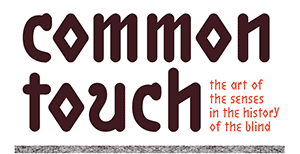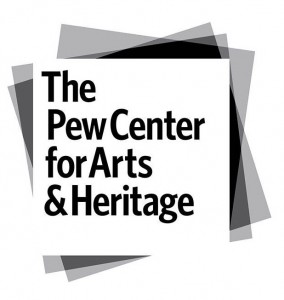Common Touch: The Art of the Senses in the History of the Blind was a multimedia exhibition that looked at historical embossed and raised-letter documents for the visually impaired as a starting point for a multi-sensory exploration of the nature of perception. Inspired by her research in the Library Company’s Michael Zinman Collection of Printing for the Blind, artist-in-residence Teresa Jaynes’s exhibition was on display April 4 – October 21, 2016. Common Touch combined her own original works with historical collections that document the education of the blind in the 19th century.
Follow and comment about Common Touch on this site, Facebook, Twitter, and Tumblr #CommonTouch or email epiola@librarycompany.org.
Common Touch: The Art of the Senses in the History of the Blind has been supported by The Pew Center for Arts & Heritage.

![Picture shows exhibition visitors interacting with Teresa Jaynes’s Gift #2, a papier mâché owl on a wooden, sideways, cylindrical stand. In the right, the left hand of a man touches the front of the owl. The owl has yellow eyes and tan and white paper feathers. Part of the man’s right hand, which holds the top of a cane is also visible. In the left, a woman with long blond hair and wearing a green sweater touches the back of the owl. She stands between a women, with medium-length dark hair and wearing a purple zip-up cardigan, to her left, and the arm of another woman in a red sweater touching the back of the owl, to her right. The woman in purple, who also wears glasses, has her hands in fists and touching. Her knuckles touch in an explanatory gesture. Other gallery visitors walk and look at other parts of the exhibition in the background. [end of description]](https://commontouch.librarycompany.org/wp-content/uploads/2016/06/CT-OPENING_KA_0199-1-e1466453388239.jpg)
![Picture shows the gallery, including four of Jaynes’s seven installations on view. In the center foreground is Jaynes’s Gift#1 on display on a flat, horizontally-angled rectangular table with a dark wood base. A white and brown paper owl rests on a cylindrical stand to the left of a large open book under a rectangular, clear acrylic hood. To the right of the display with the owl stands Jayne’s Gift #5, a map representation of the travels the 19th–century blind surveyor John Metcalf. It is a vertically-positioned, large rectangular table composed of a a linen top and a light brown wood base. A multi-color grid, outlines of geometric shapes, and green porcelain geometric shapes adorn the linen top. In the center background, on the back wall painted off-white, is Jayne’s Gift #4, a visual transmutation after the musical work of blind African American musician Thomas Wiggins. It is three horizontal and three vertical rows of prints in a geometric interplay of greens, browns and yellows. To the right of the prints on the wall is a small wooden frame in which brass musical notes are displayed. To the far right background is a view of Jaynes’s Gift #6, the scent mechanism the olfactometer, in a niche in an off-white curved wall. The floor of the room is covered with a tan colored carpet. [end of description]](https://commontouch.librarycompany.org/wp-content/uploads/2016/06/mckinnis-galleryshot-e1467064946456.jpg)
![Picture shows a man and woman touching the sculptural letters and two large frames of Gift #2. A woman, with long dark hair and a tan coat, holds a large sculptural letter from the frame closer to the viewer in her left hand. To her right, a man in a grey suit jacket touches the felt covering of the frame farthest from the viewer. In the background, the screen prints of Jaynes’s Gift #4 and another woman visitor is visible. [end of description]](https://commontouch.librarycompany.org/wp-content/uploads/2016/06/2016-04-20-terrygalloway-04-e1467063103578.jpg)
![Picture shows several visitors, including a young boy, touching and viewing the installations in the center and east wall of the gallery. In the far left is a large book under a clear, mylar hood in a display case. In the left is Jayne’s Gift #5, a map representation of the travels the 19th–century blind surveyor John Metcalf. It is a vertically-positioned, large rectangular table composed of a linen top and a light brown wood base. A multi-color grid, outlines of geometric shapes, and green porcelain geometric shapes adorn the linen top. In the center background, on the back wall painted off-white, is Jayne’s Gift #4, a visual transmutation after the musical work of blind African American musician Thomas Wiggins. It is three horizontal and three vertical rows of prints in a geometric interplay of greens, browns and yellows. [end of description]](https://commontouch.librarycompany.org/wp-content/uploads/2016/06/2016-05-18-annual-meeting-62.jpg)
![The Students’ Magazine. Philadelphia: Pennsylvania Institution for the Instruction of the Blind, 1838. Picture shows an open volume of “The Students' Magazine: Published Monthly, at the Pennsylvania Institution for the Instruction of the Blind” (Philadelphia, 1838) printed in raised-letter line type. The volume is open to an oblique view of a title page. Letters are in capitals and the text is not easily legible given angle of view. Part of the header is legible and reads: STUDENTS’ MAG. Part of the opposite page with embossed type is visible. [End of description]](https://commontouch.librarycompany.org/wp-content/uploads/2015/04/slide1_homeCT.png)
![William Moon, A Simplified Alphabet for the Use of the Blind. Brighton, England, 1893.Picture shows cover page to William Moon’s “A Simplified Alphabet for the Use of the Blind” (Brighton, 1893?). On the top of the page is the title. Between the words “Alphabet” and “for” is the royal seal captioned “Under the Patronage of Her Most Gracious Majesty The Queen.” Seal includes images of a lion and a unicorn. Beneath it reads “Invented by William Moon, L.L.D., &c. Note: The Dotted Marks of the Letters Printed Over the Alphabet for the Blind, Show What Portions of the Common Letter are Omitted, in Order to Lay the Characters Open & Clear To The Touch.” Next line printed in Moon type for the letters A-N with the next line down printed in Moon type for the letters O-Z as well as for the symbol “&” and “Th” for “The.” In the middle of the page is the caption “Classified Alphabet.” Beneath it is a line of letters in Moon type grouped into four sets with the next line also in four sets of letters in Moon type. Next line printed in Moon type for contractions, numerals, and punctuation, including “ING,” ‘MENT,” “TION,” “NESS,” “2,4,6,8,3,5,9” “Short Stop,” ‘Full Stop,” “Parenthesis,” “Division of Verses,” and “!” Printed text identifies each Moon type character. Bottom of page reads: “Instructions: In Teaching the Alphabet, Care Should be Taken to Explain the Alterations Made in the Letters, as Indicated by the Dotted Lines, (See The Note Above The Alphabet). The First Line of Reading is Read from Left to Right, and the Second from Right to Left to Prevent the Reader Losing his Place; The Brackets Guide the Finger from Line to Line. Words Ending in Ing, Ment, Tion, and Ness Have the Last Letter Put for the Whole Syllable, Also for Ing, T for Ment, &c. The Dots One Above the Other Giving Notice of The Contraction. The First Letters of Lord, God, Jesus, and Christ, Always Stand for Those Holy Names. Two Dots Side By Side, are Used for A Full Stop, A Single Dot for Any Shorter Stop. Verses are Divided by Two Short Lines One Above the Other. [Picture of a dot over a line] Stands For TH & THE. “Moon’s English Alphabet” printed vertically on left edge of page. Bottom of page reads “Published at 104, Queen’s Road, Brighton, Sussex.” [End of description]](https://commontouch.librarycompany.org/wp-content/uploads/2015/04/slide2_homeCT.png)
![J. C. Wild, Pennsylvania Institution for the Instruction of the Blind. Philadelphia, 1838. Hand-colored print. 6.5 x 7.25 in. Picture shows a four-story rectangular building with many rectangular windows. The building includes two front entrances with porticos. The structure is white, and its front is lit by sunlight. Pedestrians – eight total with six men, two ladies, and one boy – walk on the sidewalk in front of and across from the building. Small trees evenly line the sidewalk in front and to the left of the building. A dark-colored watchman’s guardhouse, shaped like a chimney, stands across the street from the building. A man with a cane, and a boy, holding his hand, walk past the guardhouse. The boy appears to be gesturing in the direction of the guardhouse and the building. [End of description]](https://commontouch.librarycompany.org/wp-content/uploads/2015/04/slide3_homeCT1.png)
![[Portrait of Hostetler family of blind musicians]. Mount Pleasant, Penna, [ca. 1866]. Picture shows one woman and three men, seated next to each other, and holding instruments. The woman holds an accordion in her lap and she looks slightly down. To her left is a man, his eyes closed, who holds a viola perpendicular to his lap with one hand and a bow in his other. To his left is a man resting a cello between his legs. He holds a bow across the base of the cello with his right hand. To his left is the last man, his eyes closed, who holds a violin by his left shoulder and a raised bow in in his right hand. The woman, as well as the man who holds a cello, wear glasses. The woman wears a dark-colored corseted dress with long sleeves and a long skirt. The men, who look toward the viewer, are bearded and wear dark-colored suits. [End of description]](https://commontouch.librarycompany.org/wp-content/uploads/2015/04/slide5_homeCT.png)


